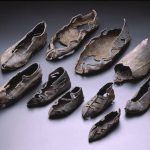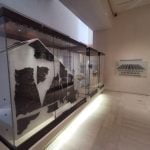Preserved Roman shoe was found in the Roman fort of Bar Hill (part of the Antoninus Wall) in the south of Scotland. The artefact can be seen at The Hunterian in Glasgow (Scotland).
Usually, Roman military sandals (caligae) had a thick, nailed sole, consisting of several layers of goat, sheep, cow or ox skin. It seems to me that here we are dealing with a civilian version that covers the foot more. Black skin was achieved probably thanks to the dye sutorium inkum, containing copper sulphate. It seems to me that a sandal could have been worn by a wealthier person.
It should be noted that the shoes were usually worn in the natural colour of the skin; however, people who could afford it had dyed shoes. The following colours could be achieved: red, yellow, white, gold, and purple. The skin was impregnated with a kind of tree bark liquid, mineral salts and others.
In colder climates (e.g. Britain), socks were also worn over the foot to protect against the cold. The sandals were attached to the feet with straps covering the instep and the lower leg. There were also versions of sandals with additional leather or metal uppers covering the entire shin.







